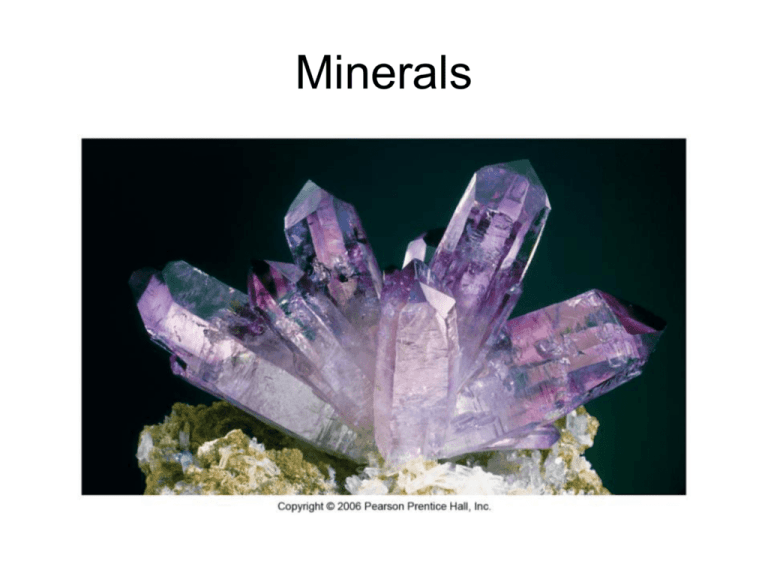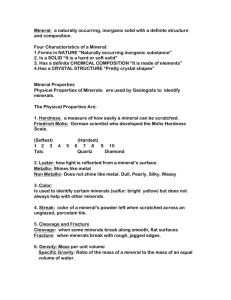
Minerals
Minerals: Building blocks of rocks
To be considered a mineral, a substance
must:
• be a naturally occurring solid
• be formed by inorganic processes
• have a crystalline structure (orderly
molecular arrangement)
• have a specific chemical composition
• An element is a substance that cannot be
broken down into simpler substances by
chemical means
• Minerals are made up of one or more elements
Most abundant elements of the
continental crust
• Common rockforming minerals are
mostly chemical
compounds made up
of these elements
• How do these
elements combine to
make minerals?
Atoms, molecules and ions
• Atoms are the smallest
individual particle that
retains the distinctive
chemical properties of an
element.
• Molecules are the smallest
individual particle that
retains the distinctive
chemical properties of a
chemical compound.
Molecules consists of 2 or
more atoms.
• Ions are atoms or
molecules that have a net
electrical charge. They
attract oppositely-charged
ions to form chemical
compounds.
Crystalline Nature of Minerals
• Crystal: any
substance whose
atoms are
arranged in a
regularly
repeating pattern
• Crystal growth is
often interrupted
due to:
– lack of space
– rapid cooling
rate
Luster: Appearance of a mineral in
reflected light
• Metallic (pyrite)
Nonmetallic: glassy/pearly
(potassium feldspar)
Luster: Appearance of a mineral in
reflected light
• Nonmetallic- waxy
(ex: chert)
• Nonmetallic –greasy
(quartz)
Color
• Often highly
variable for a
given mineral
due to slight
impurities in
crystal
structure
• For example,
quartz (SiO2)
exhibits a
variety of
colors
Other Physical properties of
minerals
• Streak
• Color of a mineral in its powdered form
• Helpful in distinguishing different forms
of the same mineral
• Hardness
• Resistance of a mineral to abrasion or
scratching
• All minerals are compared to a standard
scale, the Mohs Scale of Hardness.
Streak – the color of
a powdered mineral
Figure 2.10
Hardness
• Resistance of a
mineral to
abrasion or
scratching
• All minerals are
compared to a
standard scale
called the Mohs
scale of
hardness
Cleavage
• Tendency to break along planes of
weak bonding
• Produces flat, shiny surfaces
• Described by resulting geometric
shapes, and
– Number of planes
– Angles between adjacent planes
Three examples of perfect
cleavage – fluorite, halite,
and calcite
Copyright © 2006 Pearson Prentice Hall, Inc.
Common
cleavage
directions
Classification of Minerals
Rock-forming minerals
• Common minerals that make up most of
the rocks of Earth’s crust
• Only a few dozen members
• Composed mainly of the 8 elements that
make up over 98% of the continental
crust
8 most common elements
Classification of Minerals
• In most cases, minerals are grouped
according to the major “building
block” in the chemical structure.
• Silicates (SiO44-)
• Oxides (O22-)
• Sulfides (S2-)
• Sulfates (SO42- )
• Carbonates (CO32-)
• Halides (Cl1- , F1- Br1- )
• Native Elements (single element)
Rock-forming Minerals – The Silicate
Group
• Most common mineral
group due to large amounts
of silicon and oxygen in
Earth’s crust
• Basic building block is the
silicate ion: Four oxygen
ions surrounding a much
smaller silicon ion.
• Polymerization: process by
which silicate ions bond to
form more complex ions,
such as rings, chains,
sheets or 3 dimensional
frameworks.
Common Silicate minerals
• Olivine Group
http://www.youtube.com/watch?v=wFRB6T4AJbs
– High temperature Fe-Mg silicate
– Individual silicate linked together by iron and
magnesium ions
– Forms small, rounded crystals with no cleavage
Common Silicate minerals
• Pyroxene Group
http://www.youtube.com/watch?v=9WH_VimxA9Y
– Single chain structures involving iron and
magnesium
– Two distinctive cleavages at nearly 90 degrees
Common Silicate Minerals
• Amphibole Group
http://www.youtube.com/watch?feature=endscreen&v=fBMeVK_O3HQ&NR=1
– Double chain structures involving a variety of
ions linking the silicate ion
– Two perfect cleavages at non right angles
Hornblende is the most common mineral in the
amphibole group
Common Silicate Minerals
• Mica Group
http://www.youtube.com/watch?v=EQKXqeQFyBU
– Sheet structures that result in one direction of
perfect cleavage
– Biotite is the common dark colored mica.
Common Silicate Minerals
• Mica Group
http://www.youtube.com/watch?v=_QJgwqMwXM8
– Sheet structures that result in one direction of
perfect cleavage
– Muscovite is the common light colored mica.
Classification of Minerals
• Common Silicate minerals
• Feldspar Group
– Most common mineral group
– 3-dimensional framework that exhibits two
directions of cleavage at 90 degrees
– (potassium feldspar) (e.g. Orthoclase or
Microcline)
– Plagioclase (sodium and calcium feldspar)
are the two most common members
Feldspar Minerals
http://www.youtube.com/watch?v=zGyaM29yxKI&feature=related
Potassium feldspar - Orthoclase
Copyright © 2006 Pearson Prentice Hall, Inc.
Calcium-rich plagioclase feldspar
http://www.youtube.com/watch?v=eWSpnr9QX74
Quartz
Consists entirely of silicon and oxygen (SiO2).
This is a material called silica.
Strong bonds in all directions – cleavage absent.
Naturally clear, but impurities cause colors.
http://www.youtube.com/watch?v=kJkkmyGxcQk
Chert – Cryptocrystalline Quartz
Nonsilicate mineral groups
Fluorite (left, calcium fluoride) and
halite (right, sodium chloride) are
members of the Halide mineral
group. The minerals in this group
have, as part of the chemical
structure, an ion from the halogen
elements: Fl1- , Cl1- , I1- , or Br1- .
Gypsum (calcium sulfate) is a
member of the sulfate group. The
building block for minerals in this
group is the sulfate ion, SO42- .
The Carbonate Group
• Carbonates are
minerals found in
exoskeletons of marine
organisms.
• Calcite (calcium
carbonate – CaCO3) is
the most important
carbonate mineral.
• It has a nearly perfect
rhomboid cleavage
• It will dissolve if
exposed to acid (as
shown in the video).
“Strong bones, strong teeth”
Nonsilicate Rock-forming mineral
groups
• Sulfates – minerals
containing the
sulfate ion
• Gypsum (Calcium
sulfate: CaSO4 –
2H2O. A product of
rapid evaporation of
ancient seas.








